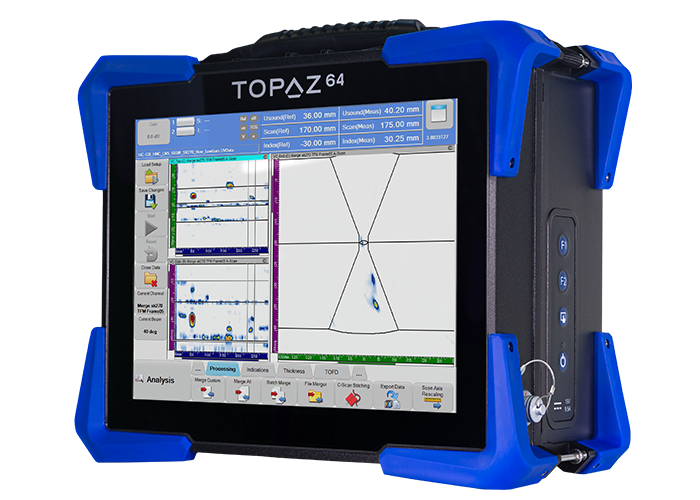How to Better Detect Corrosion in Pipe Elbows
Ask an expertPipelines are critical to operations in diverse industries including, but not limited to, water, oil and gas, and power generation. Therefore, ensuring they remain fit for service is a high priority within these sectors. Given that these pipelines are typically constructed from iron or steel, corrosion serves as a real threat to their structural integrity. That is where non-destructive testing for pipeline corrosion comes in. Ultrasonic testing has been widely accepted as the ideal technique for detecting corrosion in pipes, with phased array ultrasonic testing allowing for precise wall thickness measurements to help determine the presence of this otherwise hidden damage mechanism. Yet, the physical inspection of pipe along the bends or angles encountered has been identified as problematic.
The Challenge
Considering the complex geometry of pipes due to bending or additional fittings paired with the inflexibility of available probes and scanners, identify a better solution for detecting corrosion.
Angles and bends in pipework are essential to directing internal contents, but it can be a rigorous job for industries to keep these sections from failing as pipe elbows can be the point of erosion and corrosion in a pipe system. The high velocity of fluid passing through the pipe and turbulence contributes to the corrosion of material at the internal part of the pipe. Turbulence is high, especially where the pipe bends or is at an angle. This makes such angular edges the weaker point in a pipeline. Corrosion can encourage stress-induced cracks giving rise to pipe leaks or ruptures. This clearly presents a potential risk not only to operations but also human lives.
The inspection of small diameter pipe elbows for corrosion constitutes a challenge because of the sudden surface shape changes between intrados and extrados. Multiple pipe diameters must be inspected, preferably with the same probe configuration. The main drawback of available probes and scanners for the inspection of pipes is their inflexibility. Therefore, when inspecting complex geometrical shapes, this equipment may not be able to provide complete coverage, leaving technicians with interpolated analysis based on spot check data. This process can be extremely taxing and time-consuming and may not provide precision in analysis. And while fully automated scanners are an option, they can be too laborious to deploy in the field. An efficient NDT technique is required to identify all possible flaws in a pipe system to help prevent failure and ensure optimal performance.
The Solution
A specialized scanner that adapts to surfaces makes it easier to maneuver on the pipe and to transition from extrados to intrados and cheeks seamlessly.
Technicians faced with the challenge of corrosion detection in pipes—especially in pipe fittings and angles—are turning to advanced flexible and adaptable NDT scanners and probes as the better solution. The ElbowFlex scanner was developed for inspecting carbon steel pipes and elbows. Featuring magnetic, adjustable wheels that allow the device to adapt to surfaces from 100 millimeters (4 inches) NPS to flat, the scanner maneuvers on the pipe and transitions from extrados to intrados and cheeks seamlessly. The ability to conform to changing and complex geometries enables complete inspection coverage. Data acquisition is managed by a single button, no extra manipulations are necessary to start, pause, set the next index line, or reset. With high-resolution imaging, operators can identify the extent of corrosion and make decisions on ideal mitigating efforts for such defects. Accuracy and precision provide industries the much-needed reliability of inspection for continued safe and quality operations.
As with most inspections, a couplant is needed, and the Aqualink wedge requires only a thin film of water or water-based gel for the scanner to be adequately coupled to the elbow. A couplant pump is available as an option. It is a compact peristaltic pump unit that comes with Pelican casing. The pump is battery operated and has over 20 hours of continuous operation capacity. It can be controlled by the ElbowFlex button or directly from the pump. The couplant pump can handle water-based gels in addition to water on its own and it strongly reduces the amount of couplant spilled.
The flexible phased array ultrasonic testing (PAUT) probe operates in a pulse-echo mode and the UT performance is comparable to solid PAUT probes or Rexolite wedges. It can cover up to 50 millimeters (2 inches) circumference in a single line and the performance is comparable to LM 5 MHz, beyond near-surface dead zone 3 to 4 millimeters (0.12 to 0.16 inches).
The TOPAZ64 is a portable 64-channel PAUT instrument delivering faster, more reliable inspections. It intelligently combines the power of 64 active channels for PAUT applications with the most advanced full matrix capture, total focusing method, and plane wave imaging capabilities. It is powered by an integrated complete inspection software that allows for efficient setup, recording, and analysis; it also has onboard corrosion data analysis tools and an export C-Scan data tool (*.txt file) for transferring inspection data to proprietary customer software or Excel. For advanced analysis and data management, the software also has a tool to compensate for thickness variations of Aqualink wedges and outer diameter surface geometry variations.
Benefits
- Complete solution offers a seamless workflow, allowing the inspector to perform the advanced analysis, processing, and exportation of corrosion data efficiently.
This complete inspection solution package replaces the traditional grid type examination with encoded manual scanning sequences, generating high resolution C-Scan images with the use of the scanner combined with a flexible high-resolution phased array ultrasound probe, portable PAUT unit, and powerful onboard software. Eddyfi Technologies’ specialized NDT inspection solution delivers accurate and precise results for inspectors performing corrosion mapping in carbon steel pipes and elbows. Contact us to discuss implementing tools designed with you in mind today.
